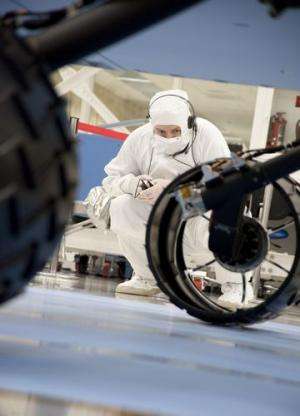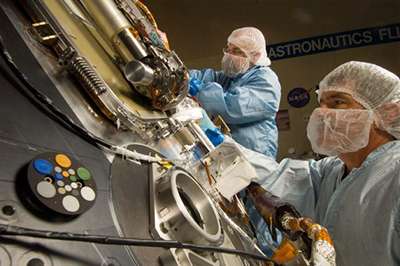The overprotection of Mars?

A recent commentary paper published in the journal Nature Geoscience argues that planetary protection policies and practices designed to guard solar system bodies from biological contamination from spacecraft need to be re-evaluated because they are "unnecessarily inhibiting" a more ambitious agenda to search for life on Mars.
In the paper, called The Overprotection of Mars, co-authors Alberto G. Fairén of the Department of Astronomy, Cornell University and Dirk Schulze-Makuch of the School of the Environment, Washington State University, also argue that, from an astrobiological perspective, the most interesting missions to "Special Regions" - where, in theory, Mars life could exist or Earth life could survive - are rendered "unviable" as a result of onerous Committee on Space Research (COSPAR) planetary protection protocols and the need to comply with "detailed and expensive sterilization requirements."
For Fairén, the key point of the paper is that, if life can be transferred to Mars in our spacecraft, then the transfer can also happen "naturally, with or without our spacecraft" - and that most likely it "has already happened."
"If Earth life cannot thrive on Mars, we don't need any special cleaning protocol for our spacecraft; and if Earth life actually can survive on Mars, it most likely already does, after four billion years of meteoritic transport and four decades of spacecraft investigations not always following sterilization procedures," he says.
"Planetary protection policies are at least partly responsible for the lack of life-hunting Mars missions since Viking, as they impose very stringent requirements for sterilization of the spacecrafts which, in my opinion, are not necessary," he adds.
A Bug in the Program
In Fairén's view, one of the main shortcomings of current planetary protection policies is that "no spacecraft is treated entirely" - including, for example, some pieces intended to burn in the Martian atmosphere, as well as the launching system - but the "actual" hardware touching down on the surface of Mars is in contact with these other "dirty" parts for several months
"This has happened in all Mars missions. Absolute sterilization does not exist, even treated spacecrafts carry hundreds of thousands of bugs. This has also happened in all Mars missions," he says.
"The best sterilization procedure is the exposure of the spacecrafts to solar and cosmic radiation during the trip and once on the surface of Mars," he adds.
According to Fairén, we already "know for sure that bugs from Earth vessels have landed on Mars" - and he firmly believes that all existing sterilization procedures will be "outdated the second we send a human to Mars."

"NASA's program of human exploration of the Solar System includes sending humans to Mars in the 2030's, and it won't be a surprise if other nations also try to put a human on Mars even earlier. You can't sterilize humans, and as soon as an astronaut steps on Mars, you will have Earth bacteria on Mars. Are all these complicated procedures valid just for the next two decades? What happens next?" he says.
The Search for Extant Life
Fairén also says that existing policies hinder the search for extant life on Mars because of the "costs in time and money associated with the cleaning." One example he cites is that of the Viking mission, which he says devoted over 10% of its one billion dollar budget to planetary protection measures.
"We are talking about over $100 million. You can do a lot of science with that amount of money. And we cannot forget that, if our target is a 'Special Region' of Mars where life can potentially exist, then the required protocols are even more stringent. [The] bottom line is that a thorough cleaning of a spacecraft aimed [at the] in situ search for life on a special region of Mars today would cost a lot of money and effort," he says.
Even if the complete sterilization of a spacecraft "cost only $1 million," Fairén still questions the sense of spending it, and expending 'a lot of effort' on something that he stresses is "not necessary."
"Of course, if sterilization was actually necessary the cost doesn't matter, you'd have to do it. If biological contamination of Mars with spacecraft would actually be a risk [there would be] no more to say, you'd have to sterilize whatever the cost, period. But our point is that such risk does not exist - and that's what we explain in the commentary," he says.
Looking ahead, Fairén argues that planetary protection policies "should be scaled down" - with only one exception: if a mission is "specifically targeted" to the search for life, he believes that sterilization "to some extent" could be in order - primarily to avoid the possibility of discovering what he calls "false positives."
"If we find life on Mars, we need to be sure that the life we are seeing did not come onboard the same spacecraft looking for it. And that's a complicated problem," he says.
Appropriate Protection of Mars
The following issue of Nature Geoscience features an article outlining a strong rebuttal to the commentary paper - written by Catharine A. Conley, the NASA Planetary Protection Officer with the Science Mission Directorate at NASA Headquarters, and John D. Rummel, a professor of biology at East Carolina University. Rummel is the current Chair of the COSPAR Panel on Planetary Protection and in previous years was the NASA Senior Scientist for Astrobiology and NASA's Planetary Protection Officer.

In the article, called Appropriate Protection of Mars, the authors state that efforts to limit spacecraft contamination "are already continuously scrutinized in light of the latest science developments, represent the consensus of the international scientific community, and are essential for any valid plan to search for any extant or extinct life on Mars."
Moreover, the authors also contend that the premise that planetary protection is too expensive "only pertains if the objectives aren't worth the cost" - adding that they "believe that the investment is not only worth it, but essential. Preventing the contamination of the Mars environment is the best way to ensure we have a chance to understand our own origins and the potential for life on Mars, now and in the future."
"I completely disagree with the paper, both because of the errors present in logic and because of the strawman planetary provisions that they posit for 'specific recommendations for the elimination or reduction of these protocols,' [which] are almost the same as the provisions currently in place," says Rummel.
"Note that they do not elaborate the benefits to be gained for astrobiology by going to regions that can grow Earth organisms, and then introducing Earth organisms into them," he adds.
In Rummel's view, astrobiology gains from the current planetary protection policies because those policies are focused - in the "forward contamination" direction - on preserving the conditions on Mars, and other bodies, so that scientists and researchers "don't end up studying their own contamination when searching for extraterrestrial life." Without such policies, he argues that we would lose the opportunity to study life, or the lack of it, on Mars.
"They [the current planetary protection policies] only hinder the search for human-associated contamination and the potential to contaminate resources that we may one day wish to use on Mars. I don't think that that is a problem," he says.
"Every aspect of planetary protection that might 'hinder' the search for extant life elsewhere, and protect Mars resources from Earth contamination, can be solved by engineering we already know how to do - witness the Viking missions launched in 1975. So I would recommend continued investment in the technology to make that engineering less expensive and more effective, and make [the policies] expected practice rather than done by exception - as with the Mars Science Laboratory," he adds.
More information:
"The overprotection of Mars." Alberto G. Fairén, Dirk Schulze-Makuch. Nature Geoscience 6, 510–511 (2013) DOI: 10.1038/ngeo1866
Published online 27 June 2013
Journal information: Nature Geoscience
Provided by Astrobio.net




















